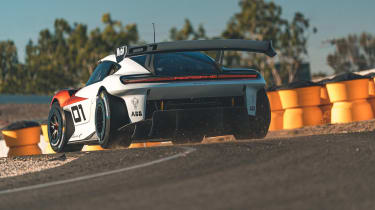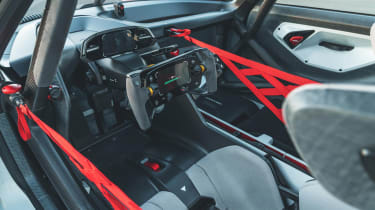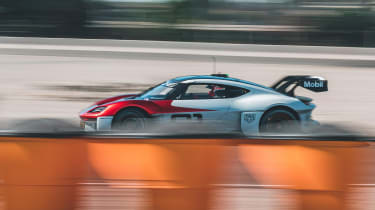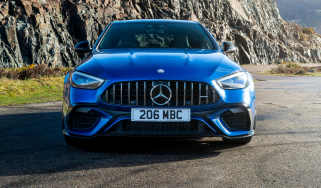Porsche Mission R review - behind the wheel of a 1073bhp concept
The all-electric Mission R concept is Porsche Motorsport's vision of the future, and we’ve experienced it first hand
I can’t see the Mission R yet, but I can hear it. It’s a frantic, frenetic, alien sound, grating and devoid of musicality. But there’s something about it that makes the hairs on the back of my neck stand to attention and my palms begin to sweat. It sounds like the sort of hunter-killer robot that might want to track you down and ruthlessly dispose of you, and frankly, it’s more than a bit scary.
The Mission R is Porsche Motorsport’s vision of the future (it may also be a significant hint as to the design of the next Boxster/Cayman if indeed it does switch to electric propulsion, although that’s not confirmed officially). Claimed to offer comparable lap times with the firm’s hugely successful one-make 911 Supercup and Carrera Cup series, it’s a carbonfibre-tubbed pure EV racing car that takes the core powertrain elements of the Taycan, ramps them up considerably, and asks the question, what might a customer EV racing car actually be like? And Porsche has now decided that it’s about time evo should sample this wild-looking new creation.
> Porsche Mission R previews new one-make racer and Cayman successor
It’s powered by two electric motors, one on each axle, which deliver a combined ‘Race’ power output of 671bhp, but can deliver over 1073bhp in the ‘Qualifying’ mode. Although the motors, gearboxes and pulse-controlled inverters are the same on each axle - thereby making replacement of these ‘modules’ easier - the peak output derived from each axle is actually different (429bhp for the front, 644bhp at the rear). These motors, although based on those in the Taycan, feature an oil cooling setup developed from the tech used in the 919 Hybrid LMP1 car (and used for the battery pack as well). The former involves oil flowing along the actual copper windings of the motor, rather than a more conventional liquid-based cooling jacket, which saves weight as well as being more efficient, something that permits full power to be used for races of up to 40 minutes. Porsche’s target weight for the car is 1500kg, which it is ‘near’ to achieving, and the 0-62mph time is a claimed 2.5sec.
Gaining entry to the Mission R is pure race car: suited, booted, and helmet on head, I fold myself ungraciously between the bars of the roll cage and settle into the racing seat. The seating position feels a long way back from the dashboard, and the actual windscreen a lot further away again, offering only the cliched letter box view of the road ahead.
More reviews
Group tests
- Lotus Emira Turbo SE v Alpine A110 GTS – two of the last surviving mid-engined sports cars
- Alpine A290 v Alpine A110 – how much DNA do they really share?
- Ariel Atom 4R v Caterham Seven ‘evo25’: power-to-weight heroes go head-to-head
- Ariel Atom 4 v Caterham Seven 310R v Lotus Elise Cup 250
- £200,000 supercar shoot-out: AMG v Aston Martin v Maserati v McLaren
- Audi Quattro, RS2 and RS3: five-cylinder icons head-to-head
- Who makes the best GT car? Aston Martin v Bentley v Maserati
- Caterham Super Seven 600 v Super Seven 2000
- Corvette Stingray v Porsche Cayman GTS v Audi R8 RWD
- Great Ferrari hypercars driven: 288 GTO, F40, F50 and Enzo head-to-head
In-depth reviews
- Abarth 600e 2025 review – Italy gives the Alpine A290 something to worry about
- Alpine A110 review – the sports car Lotus should be building
- Aston Martin Vantage 2025 review – a thrilling Mercedes-AMG GT and 911 Turbo S alternative
- Used Audi RS2 (1994) review – an unsung '90s hero you can own for £40k
- Audi R8 (2015 - 2024) review – the ultimate soft-focus supercar
Long term tests
- Abarth 695C Turismo Fast Fleet test – living with the charming Italian hatch
- Alfa Romeo Giulia Veloce long term test – can Italy beat Germany?
- Alpina B10: Alpina B10: end of term report
- Aston Martin Vantage (2006) Fast Fleet test – living with a £30k V8 Aston
- Caterham Seven evo25 Fast Fleet test – living with a track car for the road
- Caterham Seven evo Edition revealed – bespoke 420R joins the Fast Fleet
- Cupra Leon 300 Fast Fleet test – living with Spain's 300bhp hot hatch
- Cupra Ateca VZN Fast Fleet test – four months with Cupra's hot crossover
- Cupra Leon Estate 310 4Drive Fast Fleet test – living with the 306bhp hot estate
- Ford Mustang GT
Review
- New Bentley Batur 2023 review – can it possibly be worth £1.65m?
- 2023 Chevrolet Corvette C8 Z06 review – the American 911 GT3?
- BBR Supercharged Mazda MX-5 (ND) 2023 review – tuned 250bhp roadster driven
- MG4 Trophy 2023 review
Reviews
- Abarth 695 75 Anniversario edition 2024 review – a fitting send-off for Abarth’s hot supermini?
- Abarth 500e 2023 review
- AC Cobra 378 Superblower MkIV 2021 review – another V8 Cobra, but with a GM heart this time
- Acura Integra Type S 2024 review – a Honda Civic Type R with added restraint
- Alfa Romeo Giulia review – get one while you still can
- Alfa Romeo 33 Stradale 2025 review – a rare Italian jewel beyond compare
- Alfa Romeo SZ: history, review and specs of an icon
We are ready to go, but there is silence. No drama, no resonant engine sending vibrations through hard, unfurnished surfaces, but somehow the unexpected nature of what’s to come builds in the quietness and heightens the tension. I twist the mode switch on the 911 RSR-spec steering wheel to setting 1, and that’s it; the mechanics have already primed the 900V electrics, and then stood well back. A green light on the roof and dash lets us know all is well. A red light, hmmm, not so good. I’m pretty sure someone said just now that if it all goes catastrophically wrong I should jump out and run away as fast and as far as possible...
I gingerly press the accelerator pedal (there are only two pedals, naturally) and from nowhere a whine starts up, closely followed by the jolt and metallic sound of gears meshing and drive being taken up. More throttle and....whoa....the scream of the motors and the agitated wail of the differentials threatens to overwhelm my eardrums even with earplugs in place. It is deafeningly loud, and the rate of acceleration fierce. We’ll have nothing like the full beans today in this brand new concept car, but 450bhp-or-so will give us a good taster, even if the acceleration will drop off as we approach three figures. Earlier, Porsche’s record breaking test driver Lars Kern told me when he tried it with 800bhp he actually lifted off with shock. If it does that to a man with his constitution, I think we can safely say it doesn’t hang about. Just what must Qualifying power feel like then?
There’s no ABS or traction control, but there are great big fat racing slicks at each corner, especially developed by Michelin with biodegradable materials, and what appears to the naked eye as a relatively short wheelbase. Correspondingly, the Mission R feels hyper agile, changing direction with just the smallest of inputs from the reasonably light but nicely weighted and accurate electric power steering. There’s a real balance to the car as well, an adjustability you can feel as you tip in and out of the throttle; an interactivity that I hadn’t quite expected to be present somehow. You have to be a little bit careful on corner exit because the hit of torque is readily apparent, the response from the motors instant. That takes a bit of getting used to, because there are times when you have to be gradual with the throttle and not take advantage of the immediacy of the power on offer, but also times when a conventional mindset means I’m too lazy with the throttle and not capitalising on getting as much power as possible simply because it doesn’t seem feasible that 100% is available right there and then. Brain re-education is required.
The brakes blend the electric (with considerable re-gen properties) with the conventional hydraulic circuit, but the development team has done a good job of providing consistent pedal feel. There’s a little more ‘give’ to the pedal than you might have expected, but it’s not too difficult to learn, although it’s not too hard to lock a front in the bumpy braking areas if you push your luck.
Most of all - and surprisingly so - the Mission R is a whole heap of fun. I am genuinely surprised, and I’m not quite sure why, but if nothing else then the idea of electric racing cars has never really done it for me before. Yet, spending time with the Mission R proves this avenue of the future has the potential to be exciting as well as intriguing: it’s a much more physical, visceral intense experience than I had imagined, a riot of noise and commotion inside the car and a deft and involving driving experience too. A grid full of these racing for up to 40 minutes could be quite a sight, and sound.






